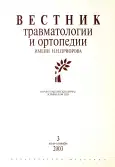Тактика оперативного лечения закрытых переломов длинных костей конечностей у пострадавших с политравмой в раннем периоде
- Авторы: Соколов В.А.1, Бялик Е.И.1
-
Учреждения:
- Научно-исследовательский институт скорой помощи им. Н.В. Склифосовского
- Выпуск: Том 10, № 3 (2003)
- Страницы: 3-9
- Раздел: Оригинальные исследования
- URL: https://journal-vniispk.ru/0869-8678/article/view/48114
- DOI: https://doi.org/10.17816/vto20031033-9
- ID: 48114
Цитировать
Полный текст
Аннотация
Проанализированы результаты лечения 218 пострадавших с политравмой за период с 1998 по 2002 г., у которых был один (127 больных) или несколько (91) закрытых переломов длинных костей конечностей. Остеосинтез этих переломов (прежде всего бедра) у пострадавших с политравмой авторы относят к срочным операциям третьей очереди. Он абсолютно показан больным с психомоторным возбуждением, при угрозе перфорации кожи костными отломками, а также в случаях, когда требуется интенсивный уход за пострадавшими для спасения их жизни. Выбор метода операции зависит от тяжести политравмы и характера перелома. Требования к прочности остеосинтеза, выполняемого по срочным показаниям, при политравме более высокие, чем при изолированных повреждениях, так как у больных, находящихся без сознания и нуждающихся в постоянном интенсивном уходе, чаще возникают ротационные смещения, миграция и деформация фиксаторов. Больным с сочетанной травмой груди противопоказан срочный интрамедуллярный остеосинтез штифтом в связи с большой опасностью развития жировой эмболии, предпочтение у них должно отдаваться накостному остеосинтезу. При отсутствии абсолютных показаний к срочному выполнению остеосинтеза его можно производить на 3-10-е сутки после травмы с использованием малотравматичных, малоинвазивных способов, не дожидаясь полного восстановления показателей гомеостаза и устранения ссадин и кровоподтеков в зоне перелома. Тактика раннего выполнения остеосинтеза при закрытых переломах длинных костей конечностей позволила сократить более чем на 10% частоту гипостатических осложнений и связанную с ними летальность и получить хорошие функциональные результаты.
Ключевые слова
Полный текст
Открыть статью на сайте журналаОб авторах
В. А. Соколов
Научно-исследовательский институт скорой помощи им. Н.В. Склифосовского
Email: info@eco-vector.com
Россия, Москва
Е. И. Бялик
Научно-исследовательский институт скорой помощи им. Н.В. Склифосовского
Автор, ответственный за переписку.
Email: info@eco-vector.com
Россия, Москва
Список литературы
- Журавлев С.М. Травматизм и ортопедическая заболеваемость — приоритетная медицинская и демографическая проблема: Актовая речь. — М., ЦИТО,1997.
- Кашанский Ю.Б., Романов В.А. //Шокогенная травма и угрожающие жизни состояния в практике скорой помощи. — СПб,1995. — С. 89-96.
- Фаддеев Д.И., Чукин Е.Г., Быстряков А.В. и др. //Материалы междунар. мед. форума «Человек и травма». — Н. Новгород,2001. — С. 102-103.
- Bardenheuer М., Obertacke U., Waydhas С., Nast- Коlb D. //Unfallchirurg. — 2000. — Bd 103, N 5. — S. 355-363.
- Behn C., Hopker W.W., Puschel K. //Versicherungsmedizin. — 1997. — Bd 49, N 3 — S. 89-93.
- Hausmann B., Hudabiunigg K. //Unfallchirurgie. — 1994. — Bd 20, N 3. — S. 162-168.
- Nast-Kolb D., Ruchholtz S. //Unfallchirurg. — 1999. — Bd 102, N 5. — S. 338-346.
- Neudeck F., Obertacke U., Wozasek G. et al. //Akt. Traumatol. — 1994. — Vol. 24, N 4. — P. 114-120.
- O’Brien P.J. //Can. J. Surg. — 2003. — Vol. 46, N 2. — P. 124-128.
- Pape H.C., Giannoudis P., Krettek C. //Am. J. Surg. — 2002. — Vol. 183, N 6. — P. 622-629.
- Pape H.C., Hildebrand F., Pertschy S. et al. //J. Trauma. — 2002. — Vol. 53, N 3. — P. 452-461; discussion P. 461-462.
Дополнительные файлы








